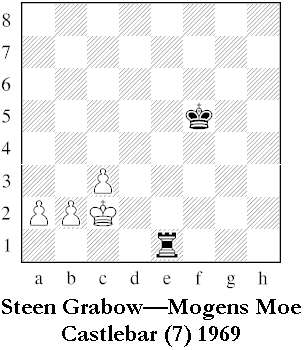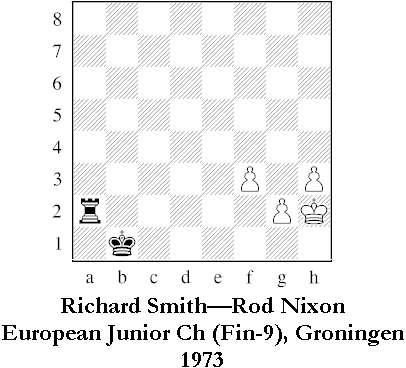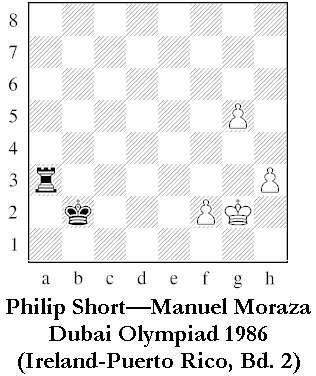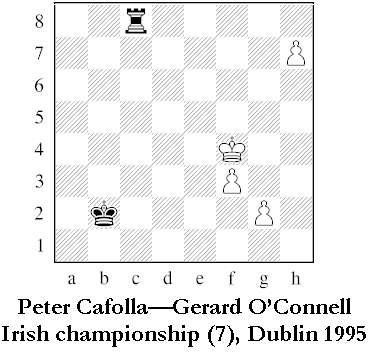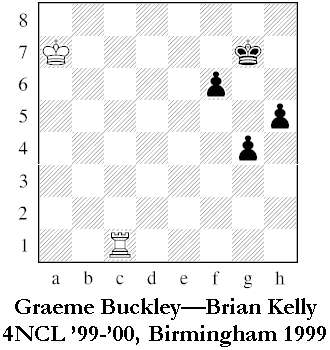Continuing the discussion of this ending from part I:
I thought this ending must be extremely rare in practice. But to my surprise Mason-Paulsen turns out to be only the first of many examples in Irish chess, i.e., where the game was played in Ireland or at least one of the players was Irish. Here is a list of all the examples I know of, excluding cases where this balance appeared only for an instant as part of an exchange: 15 more games from the ICU online games archive, 4 more from Tim Harding’s database of correspondence games UltraCorr3, and 1 from OlimpBase.
There were five Danish players in Castlebar 1969, and here two of them met in the last round. White’s pawns are nowhere near far enough advanced to cause difficulty, and Black manages a routine win:
54. a4 Ke4 55. b4 Kd5 56. Kb3 Rb1+ 57. Kc2 Rh1 58. Kb3 Rh3 59. a5 Kc6 0-1. [Replay.]
Rod Nixon played in Leinster in the early 1970’s, and played on the 1972 Glorney Cup team. He left for London around 1980 and is now playing in Oxford: he’s one of the players pictured on the cover of the latest DisinformatorTM (Oxford C.C. magazine). The European Junior when he played consisted of a preliminary stage followed by a final. He had lost to Richard Smith (Wales?) in the preliminary rounds, and here was pressing for revenge when they met again in the finals. The position is finely balanced: the pawns are still far back but the Black king is far away. It’s a draw with best play; win with the Black king at c2 instead. As it happens, both players go wrong but the errors cancel themselves out.
59. h4 Kc2 60. Kg3? (60. g4=) 60. … Ra8? (60. … Kd3/Kc3/Kb3 wins: the White king blocks the g-pawn and by keeping his rook on the 7th rank Black would force White to use several tempi to disentangle) 61. Kf4 Rh8 62. Kg5 Rg8+ 63. Kf6 Rh8 64. Kg5 Kd3 65. h5 Kd4 66. h6 Ke5 67. Kg6 Rg8+ 68. Kf7 Rxg2 69. h7 Rh2 70. Kg7 Rxh7+ 71. Kxh7 Kf4 ½-½. [Replay.]
From Smith-Nixon above, you would guess that a draw is the correct result here, and you’d be right. Unfortunately Short goes astray:
57. h4 Kc3 58. Kh3?
Now the Black king gets to e5; 58. h5/f4/Kf3/Kg3=.
58. … Kd4+ 59. Kg4 Ke5 60. f4+ Ke6 61. f5+ Ke5 62. f6 Ke6
White has managed to arrange the pawns protecting each other on the 4th, 5th and 6th ranks but is still lost according to the tablebases. The problem is that in aiding the advance of the pawns, White’s king has had to push too far forward. With the rook cutting off a retreat the king runs out of squares and is forced to allow the rook onto the h-file. Draw if the White king were at g2 here. The corresponding position with pawns at f4, g5, h6, White king at g4, Black king at g6 and rook at a3 is also lost for White, regardless of whose turn it is to move.
63. Kf4 Rh3 64. Kg4 Rh1 65. Kg3 Kf7 66. Kg4 Kg6 67. Kg3 Kh5 68. Kf3 Rh3+ 69. Kf4 Rxh4+ 70. Kf5 Rh1 71. Ke6 Kg6 72. Ke7 Re1+ 0-1. [Replay.]
Here the ending disappears almost as soon as it appears, since the h7 pawn is lost. But it would be a draw even with White to move, since Kg5 is met by … Rc5+ and the king has no shelter from the checks.
67. … Rh8 68. g4 Rxh7 69. g5 Kc3 70. g6 Rh1 71. Kf5 Kd4 72. f4 Kd5 73. Kf6 Ke4 74. f5 Rf1 75. g7 Rg1 76. Kf7 Kxf5 77. g8=Q Rxg8 ½-½. [Replay.]
Here the White king is again far afield, but now the Black pawns are dangerously advanced, especially as it’s Black to move, so here it’s White who is struggling to draw. With best play he just manages it. (Win if any of the Black pieces is advanced one square.)
60. … h4 61. Rh1! (only move) h3 62. Kb6! (only move) Kg6 63. Kc5 Kg5 64. Kd4 f5 65. Ke3 f4+ 66. Ke4 f3! (now Black needs to be careful; this is the only move to draw) 67. Ke3 Kh5! (another only move) 68. Rxh3+ ½-½. [Replay.]
To be continued …

